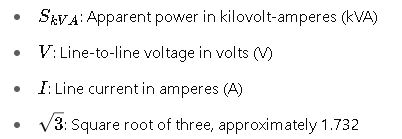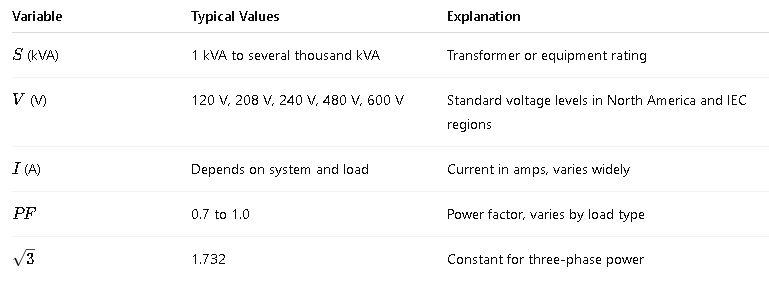Understanding kVA to volts conversion is essential for engineers managing power system design, installation, and troubleshooting.
It ensures proper transformer sizing, cable selection, and voltage compliance with detailed formulas and real-world applications.
kVA to Volts Calculator
Extensive Tables for kVA to Volts Calculation: Common Values for Electrical Systems
The relationship between kVA (apparent power), volts (voltage), and current is governed by system parameters including phase configuration and power factor. Below are comprehensive tables showcasing typical kVA values and their corresponding voltages and currents for single-phase and three-phase systems, considering common voltages in industrial and commercial installations.
Table 1: Single-Phase kVA to Volts & Current Values (Assuming Power Factor = 1.0)
| kVA | Voltage (V) | Current (A) Calculation Formula | Current (A) Example (at 120 V) | Current (A) Example (at 240 V) |
|---|---|---|---|---|
| 1 | 120 | I = kVA × 1000 / V | 8.33 | 4.17 |
| 5 | 120 | I = 5000 / 120 | 41.67 | 20.83 |
| 10 | 120 | I = 10000 / 120 | 83.33 | 41.67 |
| 25 | 120 | I = 25000 / 120 | 208.33 | 104.17 |
| 50 | 120 | I = 50000 / 120 | 416.67 | 208.33 |
| 100 | 120 | I = 100000 / 120 | 833.33 | 416.67 |
Table 2: Three-Phase kVA to Volts & Current Values (Assuming Power Factor = 1.0)
| kVA | Voltage (V) | Current (A) Calculation Formula | Current (A) at 208 V | Current (A) at 480 V | Current (A) at 600 V |
|---|---|---|---|---|---|
| 10 | 208 | I = kVA × 1000 / (√3 × V) | 27.8 | 12.0 | 9.6 |
| 25 | 208 | I = 25000 / (√3 × 208) | 69.4 | 30.1 | 24.0 |
| 50 | 208 | I = 50000 / (√3 × 208) | 138.9 | 60.2 | 48.0 |
| 100 | 208 | I = 100000 / (√3 × 208) | 277.4 | 120.4 | 96.0 |
| 150 | 480 | I = 150000 / (√3 × 480) | 180.2 | 180.2 | 150.0 |
| 200 | 600 | I = 200000 / (√3 × 600) | 138.9 | 138.9 | 192.5 |
Note: √3 ≈ 1.732
Explanation of Tables and Typical Use Cases
- Single-phase systems are common in residential and light commercial buildings, generally operating at 120 V or 240 V.
- Three-phase systems are predominant in industrial and commercial facilities, with voltages typically at 208 V, 480 V, or 600 V depending on equipment and regional standards.
- The tables assume a power factor (PF) of 1.0, meaning the load is purely resistive; however, real-world loads often have PF < 1, which impacts current values and must be considered.
kVA to Volts Calculation: Formulas and Detailed Variable Explanations
The conversion from kVA to volts depends on whether the system is single-phase or three-phase, and also on the current and power factor. Below are all relevant formulas with detailed explanations.
Basic Electrical Power Relationship
Apparent power (S) in kilovolt-amperes (kVA) is related to voltage (V) and current (I) by the following:
Where the multiplier depends on phase configuration:
- Single-phase: Multiplier = 1
- Three-phase: Multiplier = √3 (approximately 1.732)
Formula 1: Single-Phase System
Rearranged to find voltage:
Variables:

Formula 2: Three-Phase System
Rearranged to find voltage:
Variables:

Incorporating Power Factor (PF)
In many practical applications, loads are not purely resistive; thus, power factor must be incorporated.
Apparent power S relates to real power P by:
Real power P is in kilowatts (kW).
Formula 3: Including Power Factor for Three-Phase
Variable Values Common in Industry

Real-World Examples of kVA to Volts Calculations
Example 1: Calculating Voltage in a Three-Phase Industrial Motor Setup
Problem:
An industrial motor requires 50 kVA apparent power at a power factor of 0.85 and draws a current of 80 A. What is the required line-to-line voltage?
Given:
- S=50 kVA
- PF=0.85
- I=80 A
- System: Three-phase
Solution:
Use the three-phase voltage formula incorporating power factor indirectly through apparent power:
Calculate:
Since 360.9 V is not a standard voltage, the motor is likely designed for 380 V or 400 V systems common in IEC standards.
Example 2: Determining Current for a Single-Phase Transformer
Problem:
A single-phase transformer supplies a load of 10 kVA at 240 V with a power factor of 0.9. What is the load current?
Given:
- S=10 kVA
- V=240V
- PF=0.9
- Single-phase system
Solution:
First, calculate real power P:
Calculate current I based on apparent power:
If current is calculated based on real power (to size protective devices):
Thus, the transformer load current is approximately 41.67 A, but the actual power flow considering PF is 37.5 A of real power.
Additional Considerations in kVA to Volts Calculations
Impact of Load Types and Power Factor Correction
Industrial loads often have inductive characteristics (motors, transformers), leading to a lagging power factor (PF < 1). Power factor correction capacitors improve efficiency by raising PF closer to unity, impacting kVA and voltage calculations.
Voltage Drop and Regulation
In long cable runs, voltage drops must be considered. The voltage at the load may be less than the source voltage, affecting the kVA and volts relationship and requiring design margins.
Summary of Key Points
- kVA to Volts conversion requires knowledge of phase configuration and current.
- Formulas vary between single-phase and three-phase systems, and power factor influences apparent power calculations.
- Tables provided summarize typical values encountered in industry.
- Real-world examples clarify the application of formulas and help select appropriate voltage or current ratings.
Authoritative External References
- IEEE Std 141-1993 (Red Book) — IEEE Guide for Electric Power Distribution for Industrial Plants:
https://standards.ieee.org/standard/141-1993.html - National Electrical Code (NEC) Handbook, NFPA 70:
https://www.nfpa.org/70 - IEC 60038 — Standard Voltages:
https://webstore.iec.ch/publication/616 - Electrical Power Systems by C.L. Wadhwa (Textbook):
https://www.amazon.com/Electrical-Power-Systems-C-L-Wadhwa/dp/8120311111
Common Mistakes to Avoid When Using a kVA to Volts Calculator
- Ignoring Power Factor:
Neglecting power factor results in underestimation of current and incorrect sizing of equipment. - Confusing Line and Phase Voltages:
In three-phase systems, always distinguish between line-to-line and line-to-neutral voltages. Use correct formula. - Assuming Balanced Load:
Real-world loads may not be perfectly balanced, especially in older facilities or mixed systems. - Using Nominal Voltage Without Verification:
Check actual service voltage with a multimeter or data from the utility provider before using the calculator. - Neglecting Environmental Corrections:
Cable ampacity and voltage drop can be affected by ambient temperature, conduit fill, and installation method (refer to NEC Tables 310.15(B)(2)).











